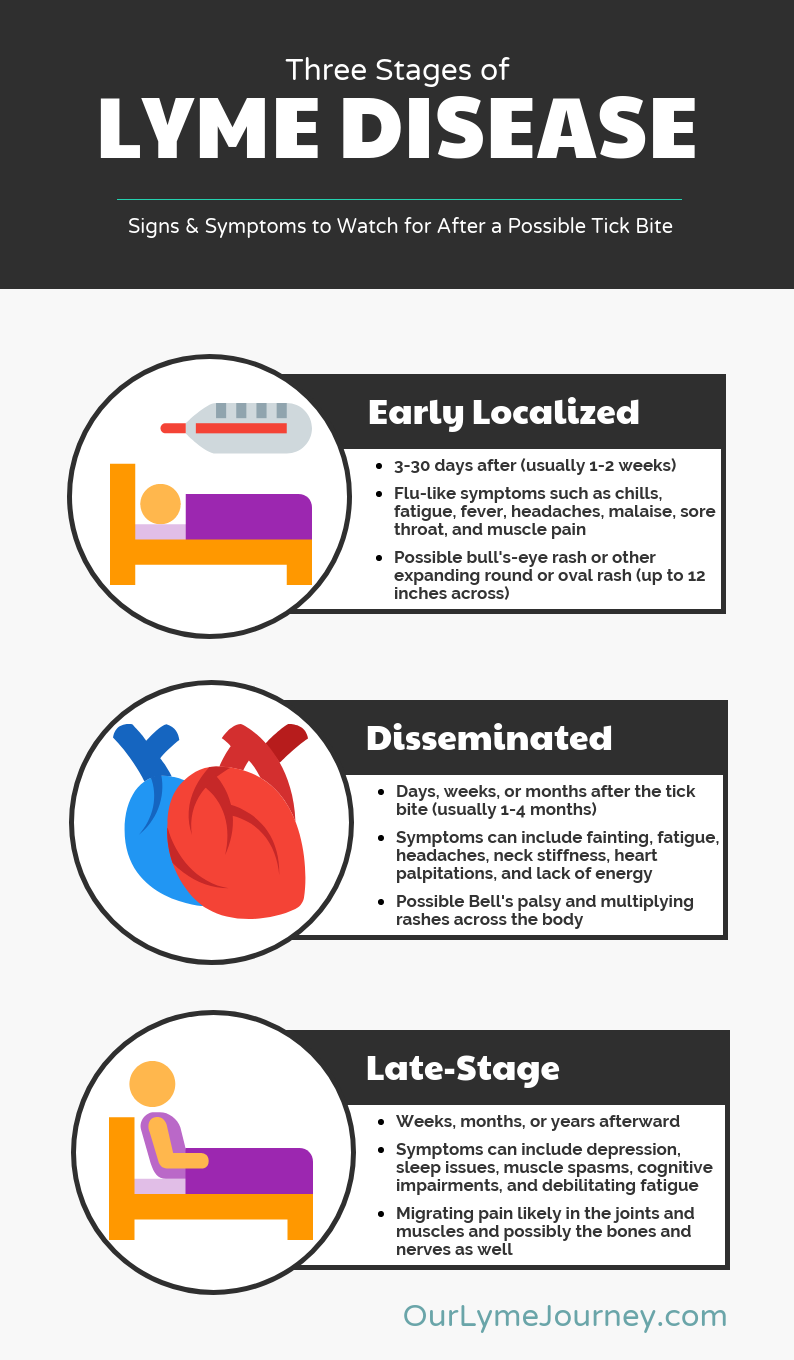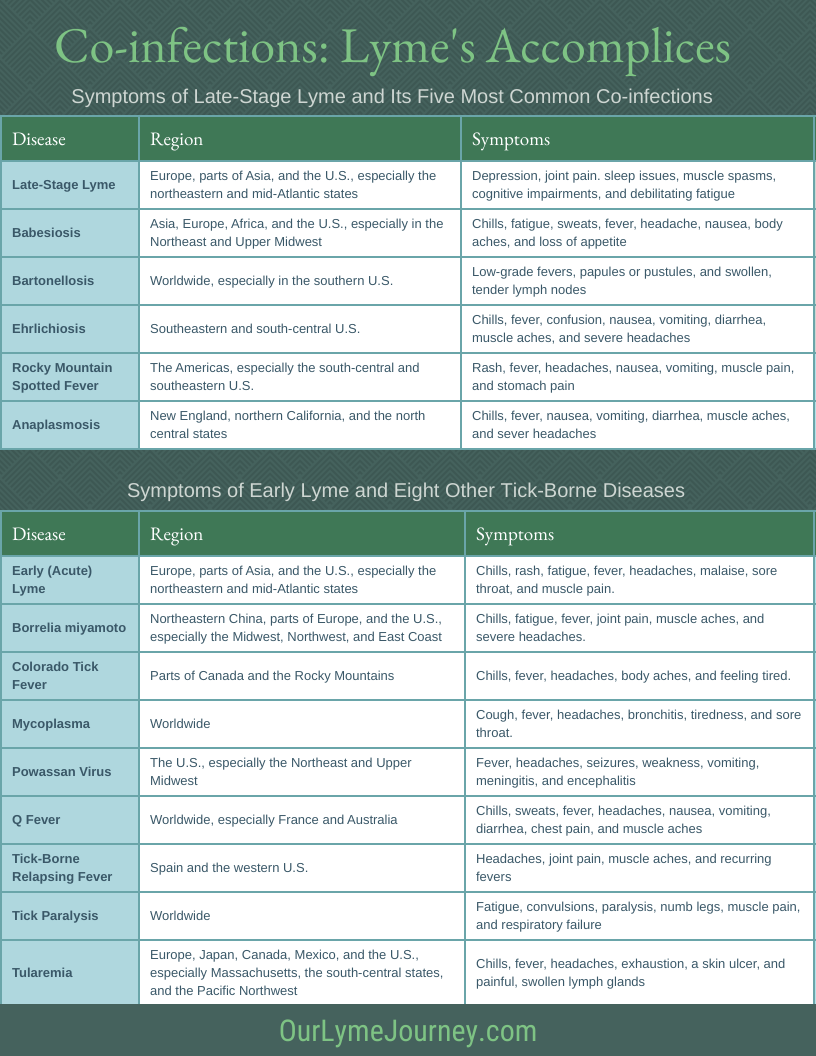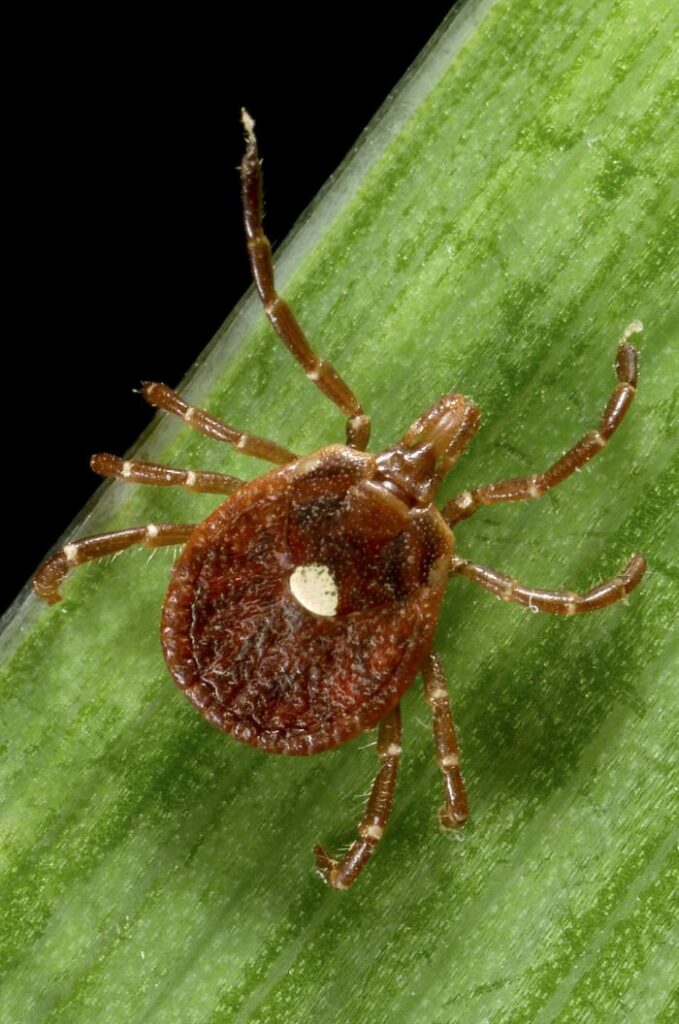Lyme is not the only disease you can get from a tick. In fact, just here in the States, at least sixteen wreak havoc. If you suffer from chronic Lyme, you likely have at least one or two co-infections.
Last week, a friend texted me, worried her daughter may have been bitten by a tick. They live in Illinois, but they had just spent a week in Tennessee where they’d gone hiking. Upon returning, my friend’s daughter spiked a fever and got a headache and stomachache.
Later that day, we spoke on the phone. Could her daughter have Lyme disease? Or maybe it was Rocky Mountain Spotted Fever? Both diseases are tick-borne diseases with similar early symptoms.
So, how do we distinguish between Lyme and all these other tick-borne diseases? How do we know if we have Lyme and co-infections? Blood tests help, but how do doctors even know what to test you for?

For each tick-borne disease below, we’re going to answer three questions:
1. Where is it commonly found?
2. What signs and symptoms do people experience?
3. When do they appear?
May this information help you advocate for yourself and your children.
Lyme Disease
According to LymeDisease.org, “Lyme has been found in all fifty states and is on the rise.” In fact, cases have been reported in more than eighty countries.
In Europe, parts of Asia, and the United States, Lyme abounds. Still, it’s most prevalent in our northeastern and mid-Atlantic states. The west coast and north central states are also becoming hot spots.
But what signs and symptoms might you notice, and when do they appear? Check out my infographic below for a snapshot of each stage.

Unfortunately, if you have a co-infection too, your illness will likely be worse. So, what are the co-infections?
Co-infections
Anaplasmosis

Anaplasmosis is endemic in New England, northern California, and the north central states.
Signs and symptoms usually appear a week or two after the tick bite. They include chills, fever, nausea, vomiting, diarrhea, muscle aches, and severe headaches.
Babesiosis
For people with chronic Lyme, babesiosis is the most common co-infection. In fact, my neighbor faced this infection of the red blood cells.
This disease can be found in several continents, including Asia, Europe, and Africa. In the States, it’s endemic, especially in the Northeast and Upper Midwest.
Symptoms include chills, fatigue, sweats, fever, headaches, nausea, body aches, and loss of appetite. These symptoms usually appear one to four weeks after exposure but can take up to six months.
Bartonellosis
Of the Lyme co-infections, bartonellosis—or Cat Scratch Disease (CSD)—is the second most common. As a matter of fact, I battled this beast.
CSD can be found throughout the world, but it’s more common in our southern states.
Signs and symptoms appear one to three weeks after exposure. They include low-grade fevers, papules and pustules, and swollen, tender lymph nodes.
Borrelia miyamotoi Disease
This disease is endemic in northeastern China, parts of Europe, and the United States. Here, it’s most prevalent on the East Coast and in the Midwest and Northwest.
Signs and symptoms usually appear twelve to sixteen days after the tick bite. They include chills, fatigue, fever, joint pain, muscle aches, and severe headaches.
Colorado Tick Fever
As you might expect, this disease is endemic in the Rocky Mountains and parts of Canada. Signs and symptoms include chills, fever, headache, body aches, and feeling tired. They usually appear around five days after the tick bite.

Ehrlichiosis
This disease is most common in the south-central and southeastern United States. Signs and symptoms usually appear a week or two after the tick bite. They include chills, fever, confusion, nausea, vomiting, diarrhea, muscle aches, and severe headaches.
Mycoplasma
Mycoplasma abounds worldwide. Signs and symptoms usually appear one to four weeks after infection. They include cough, fever, headaches, bronchitis, tiredness, and sore throat.
Powassan Virus
This virus is endemic in the U.S., especially in the Northeast and Upper Midwest. Signs and symptoms usually appear one to four weeks after exposure. They include fever, headache, seizures, weakness, vomiting, meningitis, and encephalitis.

Q Fever
This infection occurs worldwide but abounds in France and Australia.
Signs and symptoms usually appear two to three weeks after exposure. They include chills, sweats, fever, headaches, nausea, vomiting, diarrhea, chest pain, and muscle aches.
Rocky Mountain Spotted Fever (RMSF)
RMSF is widespread in the Americas. It’s especially prevalent in the south-central and southeastern regions of the States. Signs and symptoms usually appear three to twelve days after the tick bite. They include rash, fever, headaches, nausea, vomiting, muscle pain, and stomach pain.
Tick-Borne Relapsing Fever (TBRF)
TBRF is prevalent in Spain and the western United States. Symptoms appear seven days after the tick bite. As its name suggests, the main sign of this disease is high recurring fevers. During these temperature spikes, patients also experience headaches, joint pain, and muscle aches.
Tick Paralysis
Tick paralysis can be found throughout the world. In the U.S., it’s most common in the south, the Pacific Northwest, and the Rocky Mountain states. Signs and symptoms usually appear five to seven days after exposure.

Early symptoms include fatigue, numb legs, and muscle pain. As the name implies, paralysis then develops, starting in the lower extremities. If not treated, the paralysis can continue upward, causing convulsions and respiratory failure. Twelve percent of untreated patients die.
Tularemia
Tularemia cases have been reported in Europe, Japan, Canada, Mexico, and the United States. Here, it’s most prevalent in Massachusetts, the south-central states, and the Pacific Northwest.
Signs and symptoms usually appear three to five days after the tick bite but can take up to fourteen. They include chills, fever, headaches, exhaustion, a skin ulcer, and painful, swollen lymph glands.

But tick bites themselves can cause a reaction that may serve as our earliest warning of one of the above diseases. So, what symptoms do tick secretions cause? Click here to discover!





Pingback: Lupus? Or Yet Another Lyme Disease Symptom? - Never Alone
Pingback: Tick Bite Symptoms: Our Earliest Warning - Never Alone
Pingback: Tick Bite Rash: A Blessing in Disguise - Never Alone
Pingback: IGeneX Lab: Sensitive Lyme and Co-infections Testing - Never Alone
Pingback: How to Treat Tick Bites in Seven Easy Steps - Never Alone
Pingback: After a Tick Bite, Watch for These Symptoms - Never Alone